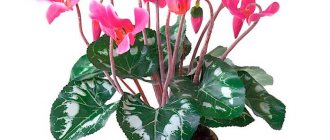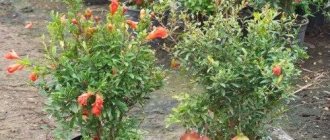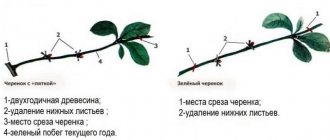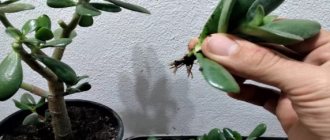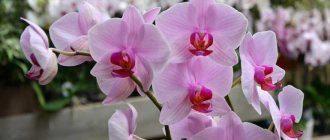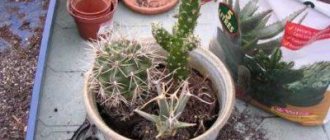It is very difficult to find flower growers who are indifferent to orchids. These plants are highly valued for their abundance, duration, spectacular flowering and amazingly beautiful coloring of the petals. Phalaenopsis is one of the most “unpretentious” and low-maintenance varieties, so even a novice orchid grower can grow it. However, difficulties often arise with plant propagation. To avoid them, you need to study in advance how to propagate an orchid at home, the process and the appropriate technology.
Is it possible to propagate a flower?
It is indeed possible to propagate an orchid at home, especially since the characteristics of this crop suggest several ways to obtain a new plant. So, you can simply divide an adult bush into several young plants, or use children or cuttings for this purpose.
In addition, the crop can be grown from seeds, but this method is much more complicated and is suitable only for those who want to master all stages of growing a crop.
When is the best time to propagate?
It is best to begin the propagation procedure one to two months after flowering has completed. The same time is also suitable for replanting a flower, since at this time the crop enters a period of vegetative dormancy and you can easily divide the bush or cut the required number of cuttings.
Unlike transplantation, which, if necessary, can be carried out with a flowering crop (for example, if pests have settled on the plant), it is better to postpone propagation until spring so that the adult plant does not experience stress from the procedure.
Cytokinin paste when diluted
Cytokinin paste is very convenient and easy to use for orchid propagation. This action is best done in late winter or early spring. At this time of year, the plant has the maximum amount of vitality.
Cytokinin paste can only be stored in the refrigerator.
Using a knife, scratch the surface of the peduncle and apply 2mm of paste there. After 10 days, a bud will begin to emerge on the stem. To awaken the bud, you need to cut off the scales and spread the paste again. After about 10 days, the bud will wake up, when the first leaves appear, transplant it into a pot.
From the video you will learn about the use of cytokinin paste on orchids:
Nutrient medium for sowing seeds
For seeds to germinate, they need a special nutrient substrate. Its consistency is a jelly-like mass with a high content of vitamins and sugars.
The nutrient substrate is based on agar-agar (a special powder made from red and brown algae). It is dissolved in boiling water (heated distilled water). As it cools, agar-agra becomes like jelly.
It is worth noting that seeds can only be planted in such a mass, since in a solid mass they will not be able to grow a root system, and in a liquid one they will simply drown. If you plan to germinate seeds, it is better to buy the nutrient medium in special stores rather than prepare it yourself, since it is difficult to create the necessary sterile conditions at home. Adult plants require a different substrate.
Cuttings
This is also a completely working and common method of reproduction. A cutting is a stem of an orchid that is separated from the mother plant. The best time for cuttings is May-June.
Procedure
- carefully separate the cuttings suitable for further rooting from the mother plant;
- remove the lower leaves of the separated shoot;
- Disinfect the cuts with charcoal;
- You can grow roots both in water and in a nutrient substrate - take good care of the plant during this period and feed it;
- when the roots grow, the cutting can be transplanted to a permanent place.
Further care
If you have successfully propagated an orchid and received a sufficient amount of planting material, it is important to provide the seedlings with optimal care. Fortunately, young plants require the same care as adult plants, with the exception of fertilizing. It makes no sense to apply additional fertilizers before the first flowering, since all the necessary nutrients are contained in the substrate.
General rules for creating the necessary conditions
Whatever method of propagating orchids you choose, there are several general care rules that must be followed before propagation.
- Only mature healthy flowers are propagated.
- Orchids must have developed roots.
- The flower contains at least 4 large leaves.
- A peduncle that is at least 1.5 years old is used.
- The development of shoots is facilitated by sharp temperature fluctuations (+17 - +30 °C).
- High air humidity is maintained.
- It is possible to spray the periflower zone.
- Poor watering (on average 10-14 days);
- Long lighting period (minimum 12-14 hours).
Proper watering
Watering plays a key role in caring for seedlings. It is important not to over-moisten the soil, as this can cause root rot. Immediately after planting the sprouts in the ground, the seedlings are thoroughly sprayed, and further watering will be required no earlier than a few days later, when the substrate becomes dry and the pot is light. Watering containers with seedlings is carried out in the same way as with adult plants, that is, by immersing the pots in water.
You can propagate an orchid by selecting only a healthy plant without fungal diseases. Growing at home is carried out in conditions with maximum lighting, so that the daylight hours are at least 14 hours. It is not recommended to use a newly purchased flower as a material. It is necessary for him to adapt at home and grow.
Methods for propagating orchids at home
The method you choose to propagate an orchid is determined by its type. Existing options include: dividing the bush, cuttings, propagation by children and seeds.
Peduncle
This method is suitable for propagating Phalaenopsis orchids and is not particularly difficult.
- After flowering, the remaining green peduncle is cut into pieces 3-4 cm in size, each having one dormant bud. The bud should be located approximately in the middle of the cutting.
- All cuts are processed with crushed charcoal.
- After this, the cuttings are placed in damp sphagnum moss, covered with glass or film on top and placed in a warm place with a temperature of 25-28.
- It is recommended to moisten the moss from time to time.
- After some time, roots form; after the leaves appear, the young plants are planted in small pots.
You can do it differently. The faded peduncle is placed in water with added fertilizer. The container with the peduncle is placed in a very warm, bright place and systematically treated with Dr. Foley fertilizer. This promotes the awakening of dormant buds and the appearance of children on the peduncle. When they are sufficiently formed, they are cut and transplanted into pots.
Children
Orchid babies can appear spontaneously simultaneously with flowering on the peduncle or from a dormant root bud. For their appearance, a very high temperature (over 28°C) and high air humidity are required. In this case, there is a high probability that a baby will begin to form from the dormant bud. Some phalaenopsis hybrids are more prone to this, others less.
Attention! The birth of babies can be stimulated using a special cytokinin paste. This is a hormonal drug that helps awaken dormant buds and the emergence of new plants. Before using the stimulating drug, you need to remove the scales covering the kidney.
It takes up to six months for a baby to grow its own roots. Only after this is it cut and planted separately. By this moment, the plant should have 3-4 leaves and up to 5 roots of its own, 4-5 cm long. The cut is made with a sharp knife; it must be disinfected in advance, leaving a small piece of the peduncle on the plant. The sections are treated with crushed coal (and on the mother plant too).
In dendrobium, calanthe, tunia, catazetum, side shoots are called children. In order to stimulate their appearance, a complex mineral fertilizer based on potassium, phosphorus and nitrogen with the addition of minerals and amino acids is used. After the shoots grow a little, all you have to do is cut them with a sharp knife and plant them in a separate container.
Cuttings
Propagation by cuttings is used for mnopoidal orchids, such as Vanda, Dendrobium, Epidendrum. This manipulation is performed in the spring so that the plant can get stronger and take root well over the summer. To do this, do the following:
- Use a knife to cut off the top of an old stem or a new young shoot with two or more aerial roots.
- The sections are treated with a fungicide and sprinkled with crushed coal to prevent infection. After this, they must be covered with garden varnish.
- The cut cuttings are planted in moss in a greenhouse. Grow a new plant in a warm place with plenty of light. The moss is kept moist.
Direct sunlight is contraindicated for rooting cuttings. Provide them with light shade.
Dividing the bush
Sympoidal species are propagated in this way: Miltonia, Cattleya, Dendrobium, Cymbidium, Odontoglossum, Oncidium. For this method of propagation, only an adult bush is suitable; at least 4 pseudobulbs must remain on each of the divisions. With less of them, you risk destroying the plant. We recommend combining the division of the bush with replanting, dividing the plant into 2-3 parts.
The procedure is carried out as follows:
- The substrate is moistened to make it easier to remove the plant from the pot.
- Then you need to pull the base of the stem and carefully remove the orchid.
- Clear the roots of the soil so that you can better see where to divide.
- Using a sharp knife, divide the main large onion into 2-3 parts so that at least 4 pseudobulbs remain on each of them.
- Powder the cuts with cinnamon or crushed charcoal. Air dry a little.
- Plant each division in a separate pot filled with a mixture of moss and nutrient substrate.
Thanks to the pseudobulbs, the orchid receives nutrition that will help it recover after division. If the seedling looks weakened, it can be rooted in a plastic bag filled with damp moss. In conditions of high humidity, it will be easier for the plant to grow roots. Such a package should be located in a warm place - this is a necessary condition for rooting the cuttings.
If you do not want to divide the adult bulb, in order not to worsen the appearance of the mother plant, you will have to wait until the young shoots form their own bulb and enter the dormant phase. This moment will be the most favorable for their separation. They are planted in separate pots and cared for like other orchids during the dormant period. Coming out of this phase, the plants will begin to grow, develop roots and continue to successfully form into adult specimens.
By dividing the bush, adult Phalaenopsis can also be propagated. As a rule, this is done with plants that have many aerial roots and leaves. The rosette is cut into 2 halves so that the leaves and roots remain on each part of the plant. Then proceed as usual. The sections are powdered with charcoal and dried. The lower part can be left in the old pot. The upper part is planted in a new container, tucking aerial roots into the soil. The stump dries out after a while, forming a basal baby. This way you get two plants.
Propagation of orchids by seeds
Propagation of orchids by seeds is usually considered difficult and is used only by enthusiasts, since everything takes a long time and with certain difficulties. Orchid seeds are like dust and have no supply of nutrients. They can germinate only in conditions of absolute sterility and sufficient nutrition. Nutrient mixtures are made on the basis of agar-agar and can be purchased at a specialty store. It will take a whole year for a sprout to appear, so few people prefer this method of propagation at home.
On a note! On an industrial scale, specialized laboratories are engaged in growing orchids from seeds.
Sterilized seeds are placed in test tubes with a nutrient solution. Changes can be noticed after a week. Small green balls are formed from the seeds, on which suction hairs are first formed and only then are leaves formed. Plants are transplanted into the ground at one year of age.
